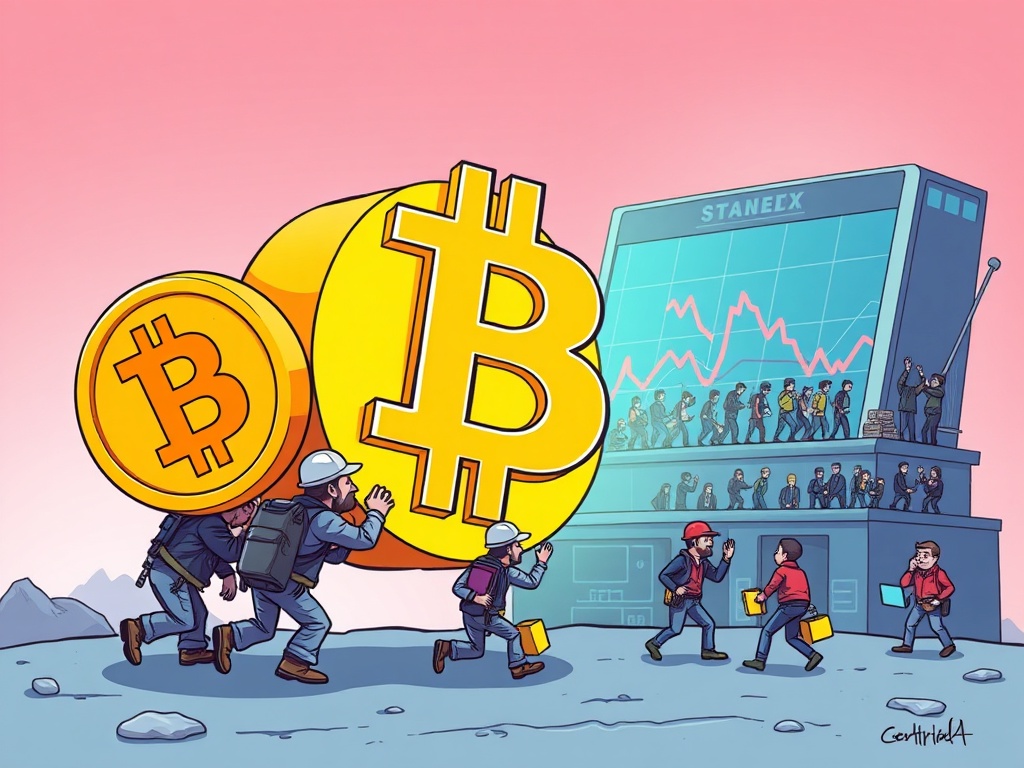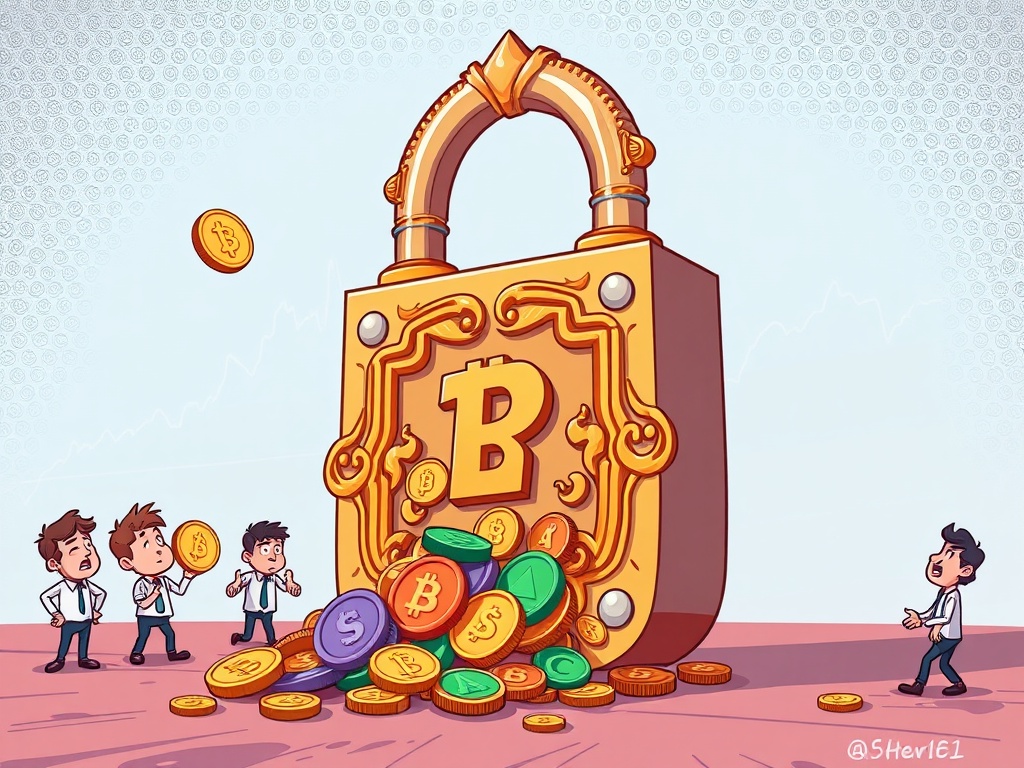BitcoinWorld

Urgent Bitcoin Miners’ $429M Deposit Sparks Market Concerns
The cryptocurrency world recently buzzed with an urgent alert: Bitcoin miners have deposited a staggering 3,726.55 BTC, valued at approximately $429.68 million, onto various exchanges. This massive influx, reported by CryptoQuant Alert, immediately raised eyebrows across the market. What does such a substantial movement from these key network participants signify? Is it a precursor to a price correction, or merely a routine operational adjustment? Understanding the motivations behind these large Bitcoin miners’ deposits is crucial for anyone navigating the volatile crypto landscape.
What Exactly Happened with Bitcoin Miners’ Deposits?
On a recent day, the crypto community was notified of a significant on-chain event: Bitcoin miners transferred a substantial amount of their mined Bitcoin holdings to centralized exchanges. Specifically, CryptoQuant Alert, a well-known on-chain analytics platform, flagged a deposit of 3,726.55 BTC, equating to nearly $430 million. This isn’t just a casual transfer; it’s a movement of funds from wallets typically controlled by mining operations directly into exchange hot wallets, where assets are readily available for trading or selling. Such a large-scale transfer often indicates an intent to sell, or at the very least, a preparation for increased liquidity.
For context, miners are the backbone of the Bitcoin network. They dedicate immense computational power to verify transactions and secure the blockchain, earning newly minted Bitcoin as a reward. Their behavior, therefore, serves as a unique barometer for the network’s health and potential market shifts. When Bitcoin miners move significant portions of their holdings to exchanges, it’s akin to a major institutional investor preparing to offload shares – it catches the attention of the entire market due to the potential for increased selling pressure.
Why Do Bitcoin Miners Move Such Large Amounts of BTC? Unpacking the Motives
The decision by Bitcoin miners to deposit such a substantial sum onto exchanges isn’t made lightly. Several factors typically drive these large transfers:
- Operational Costs: Mining Bitcoin is an energy-intensive business. Miners face significant recurring expenses, including electricity bills, hardware maintenance, and staff salaries. Selling a portion of their mined BTC is often necessary to cover these ongoing operational costs, especially in periods of lower profitability or rising energy prices.
- Profit-Taking: After periods of significant price rallies, miners might choose to realize profits. If Bitcoin’s price has surged, depositing BTC to exchanges allows them to convert their digital assets into fiat currency or other stable assets, securing their gains and improving their balance sheets. This is a common business practice in any industry.
- Market Sentiment and Hedging: Miners are sophisticated market participants. If they anticipate a potential market downturn or a significant price correction, they might move BTC to exchanges to hedge their positions or to sell before prices drop further. This proactive measure aims to mitigate potential losses.
- Hardware Upgrades and Expansion: The mining industry is highly competitive and requires constant technological advancement. Miners frequently need to invest in newer, more efficient mining rigs. Large deposits can signal an intention to liquidate assets to fund these capital-intensive upgrades or expand their mining operations.
- Consolidation and Liquidity Management: Sometimes, deposits might simply be part of a larger strategy to consolidate funds from various mining pools or individual operations into a central exchange account for easier management, or to increase liquidity for future strategic moves.
Historical Context: Do Bitcoin Miners’ Deposits Always Signal a Downturn?
The immediate reaction to large Bitcoin miners’ deposits is often one of concern, but historical data suggests the relationship isn’t always straightforward. While increased miner outflows to exchanges can certainly precede periods of price weakness due to increased selling pressure, it’s not a guaranteed one-to-one correlation. For instance, during strong bull markets, miners might sell to cover costs while demand easily absorbs the supply, leading to continued price appreciation. Conversely, in bear markets, even small miner sells can exacerbate downward trends.
Consider the periods after Bitcoin halving events. Miners’ revenue per block is cut in half, often forcing less efficient miners to sell more of their holdings to stay afloat or even capitulate. This can lead to increased supply on exchanges. However, the market typically prices in halving events, and often, a subsequent bull run absorbs this selling pressure over time. It’s crucial to look beyond a single data point and analyze it within the broader market context, including overall demand, macroeconomic factors, and investor sentiment.
The Potential Impact on Bitcoin Price: Supply and Demand Dynamics
The fundamental principle of economics – supply and demand – applies directly to the impact of large Bitcoin miners’ deposits. When a significant amount of BTC is moved to exchanges, it increases the readily available supply on those platforms. If this increased supply is not met by a corresponding increase in demand from buyers, it can lead to selling pressure, potentially pushing the price downwards.
- Increased Selling Pressure: With more BTC on exchanges, there’s a higher likelihood of it being sold. This can lead to a dip in price if buyers aren’t stepping in at the same rate.
- Market Depth: Large sell orders from miners can quickly eat through the existing buy orders on an exchange’s order book, causing slippage and faster price declines.
- Psychological Impact: News of large miner deposits can create fear, uncertainty, and doubt (FUD) among investors. This psychological impact alone can trigger panic selling, regardless of the actual market fundamentals, creating a self-fulfilling prophecy of a price drop.
- Liquidation Risks: In a highly leveraged market, a sudden price drop triggered by miner selling could lead to cascading liquidations, further amplifying the downward movement.
However, it’s also important to remember that the Bitcoin market is vast and global. A $430 million deposit, while substantial, might be absorbed relatively quickly if institutional demand is high or if the overall market sentiment remains bullish. The impact depends heavily on the prevailing market conditions at the time of the deposit.
Reading the Signals: How to Interpret Bitcoin Miner Behavior
Understanding the nuances of Bitcoin miners’ activities requires looking at a broader set of on-chain indicators. While deposits are a key signal, they are best understood when viewed in conjunction with other metrics:

| Metric | What it is | What it suggests (in relation to deposits) |
|---|---|---|
| Hash Rate | The total computational power dedicated to mining the Bitcoin network. | A falling hash rate alongside large deposits might signal miner capitulation or a significant reduction in mining profitability, suggesting more forced selling. A rising hash rate suggests miners are still profitable and confident, possibly indicating that deposits are for routine expenses or upgrades rather than distress. |
| Mining Difficulty | A measure of how difficult it is to mine a new block on the Bitcoin blockchain, adjusted every 2016 blocks. | Decreasing difficulty after large deposits could mean miners are exiting the network due to unprofitability, reducing competition. Increasing difficulty suggests the network is healthy and more miners are joining, potentially absorbing some selling pressure. |
| Puell Multiple | Calculated by dividing the daily issuance value of Bitcoin (in USD) by the 365-day moving average of the daily issuance value. | High values (miners selling at peak profitability) often suggest potential local market tops, as miners are realizing maximum gains. Low values (miners holding back, facing lower profitability) can indicate market bottoms, as miners are less incentivized to sell. |
| Miner Net Position Change | The net flow of BTC from miners’ wallets. It tracks whether miners are accumulating (positive) or distributing (negative) their Bitcoin. | Large negative values (significant selling) alongside exchange deposits indicate strong selling pressure from the mining sector. Positive values suggest miners are holding or accumulating, which is generally bullish. |
Navigating the Uncertainty: Actionable Insights for Investors Amidst Miner Movements
While a large deposit by Bitcoin miners can be a cause for concern, it’s crucial for investors to maintain a balanced perspective and avoid impulsive decisions. Here are some actionable insights:
- Don’t Panic Sell: Reacting solely to a single data point can lead to poor investment decisions. Always consider the broader market context and other fundamental indicators before making moves.
- Look Beyond the Headlines: Dig deeper into why the deposits are happening. Are they part of a larger trend, or an isolated event? Is the overall market sentiment strong enough to absorb the selling pressure?
- Dollar-Cost Averaging (DCA): For long-term investors, continuing a DCA strategy can help mitigate the impact of short-term volatility. By investing a fixed amount regularly, you average out your purchase price over time, reducing the risk associated with market timing.
- Risk Management: Ensure your portfolio is diversified and that you’re not over-leveraged. Having a clear exit strategy and stop-loss orders can protect your capital during sudden downturns.
- Stay Informed: Follow reputable on-chain analytics platforms and crypto news outlets. Understanding the narratives and data can help you make more informed decisions rather than relying on fear or speculation.
- Focus on Long-Term Fundamentals: Bitcoin’s underlying technology, increasing adoption, and limited supply are its core strengths. Short-term miner activity, while impactful, doesn’t necessarily negate these long-term bullish factors.
In conclusion, the recent $429.68 million deposit by Bitcoin miners into exchanges is undoubtedly a significant event that warrants attention. It highlights the dynamic nature of the crypto market and the powerful influence of key participants like miners. While such large transfers can signal potential selling pressure and market concerns, they are also part of the normal operational cycle for mining businesses. By understanding the various motivations behind these deposits and analyzing them in conjunction with other on-chain metrics, investors can gain a more comprehensive view of the market’s health and make more informed decisions. The key is to remain calm, conduct thorough research, and avoid knee-jerk reactions in a market driven by both fundamentals and sentiment. Staying vigilant and well-informed is your best defense against market volatility.
Frequently Asked Questions (FAQs)
1. What is a Bitcoin miner deposit to an exchange?
A Bitcoin miner deposit to an exchange occurs when a miner or a mining pool transfers Bitcoin from their wallets (where they receive mining rewards) to a cryptocurrency exchange. This action often signals an intent to sell the Bitcoin, either to cover operational costs, take profits, or reallocate funds.
2. Why are large miner deposits concerning for the Bitcoin market?
Large miner deposits are concerning because they increase the available supply of Bitcoin on exchanges, which can lead to increased selling pressure. If this supply isn’t met by sufficient buying demand, it can cause the price of Bitcoin to drop, impacting overall market sentiment.
3. Does every large Bitcoin miners’ deposit lead to a price drop?
No, not every large deposit by Bitcoin miners automatically leads to a price drop. The impact depends on various factors, including overall market demand, prevailing sentiment, macroeconomic conditions, and the specific reasons behind the miners’ sale. Sometimes, the market can absorb the supply without significant price movement.
4. How can I track Bitcoin miner activity?
You can track Bitcoin miner activity using various on-chain analytics platforms like CryptoQuant, Glassnode, or Chainalysis. These platforms provide data on miner inflows/outflows, hash rate, mining difficulty, and other metrics that help interpret miner behavior.
5. What other factors influence Bitcoin’s price besides miner deposits?
Bitcoin’s price is influenced by numerous factors beyond miner deposits, including macroeconomic news (inflation, interest rates), regulatory developments, institutional adoption, technological advancements, market sentiment, supply and demand dynamics from retail and institutional investors, and global events.
6. Should I sell my Bitcoin if I see large miner deposits?
It’s generally not advisable to make investment decisions based solely on one data point like miner deposits. Instead, consider a holistic view of the market, including broader trends, other on-chain metrics, fundamental analysis, and your personal financial goals. Consult with a financial advisor if you are unsure.
Did you find this article insightful? Share it with your friends and fellow crypto enthusiasts on social media to help them understand the intricate world of Bitcoin miners’ activities and their market impact!
To learn more about the latest Bitcoin market trends, explore our article on key developments shaping Bitcoin price action.
This post Urgent Bitcoin Miners’ $429M Deposit Sparks Market Concerns first appeared on BitcoinWorld and is written by Editorial Team





